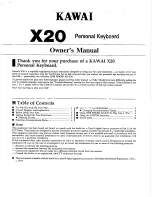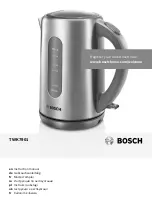
Selecting & Playing Voices
N-100
Owner’s Manual
ENGLISH
15
Selecting & Playing Voices
Selecting Voices
1.
Select the Grand Piano 1 voice by pressing the
[PIANO/VOICE] button.
Pressing the
[SELECT]
button switches among the following ten voices.
While holding down the
[PIANO/VOICE]
button, press one of the C1–A1 keys
to select a voice.
To instantly call up the Grand Piano 1 voice again, simply press the
[PIANO/
VOICE]
button.
2.
Adjust the volume.
Re-adjust the
[MASTER VOLUME]
dial for the most comfortable listening level
during your performance.
To familiarize yourself with the
characteristics of the voices, lis-
ten to the demo songs for each
voice (page 13).
TERMINOLOGY
Voice:
On the N-100, the term “voice”
means “instrument sound.”
When you select a voice, an
appropriate reverb type will be
selected automatically (page 18).
NOTE
NOTE
Key
Voice Name
Description
C1
Grand
Piano 1
Recorded samples from a full concert grand piano. Also includes three
levels of dynamic sampling, sustain samples, and key-off samples for
exceptionally realistic acoustic grand piano sound. Perfect for classical
compositions as well as any other style that requires acoustic piano.
C
#
1
Grand
Piano 2
Spacious and clear piano with bright reverb. Good for popular music.
D1
Piano &
Strings
A Dual voice combining grand piano and strings – perfect for slow,
orchestral piano music.
D
#
1
Electronic
Piano 1
An electronic piano sound created by FM synthesis.
Exceptional musical response with varying timbre according to key-
board dynamics. Good for standard popular music.
E1
Electronic
Piano 2
The sound of an electric piano using hammer-struck metallic tines. Soft
tone when played lightly, and an aggressive tone when played hard.
F1
Church
Organ
This is a typical pipe organ sound (8 feet + 4 feet + 2 feet).
Good for sacred music from the Baroque period.
F
#
1
Jazz Organ
The sound of a tonewheel type electric organ. Often heard in jazz and
rock idioms.
G1
Strings
Stereo-sampled, large-scale strings ensemble with realistic reverb. Try
combining this voice with piano in the DUAL.
G
#
1
Harpsichord
The definitive instrument for baroque music. Since harpsichord uses
plucked strings, there is no touch response.
There is, however, a characteristic additional sound when the keys are
released.
A1
Vibraphone
Vibraphone played with relatively soft mallets. The tone becomes more
metallic the harder you play.
C0
C1
A1
















































